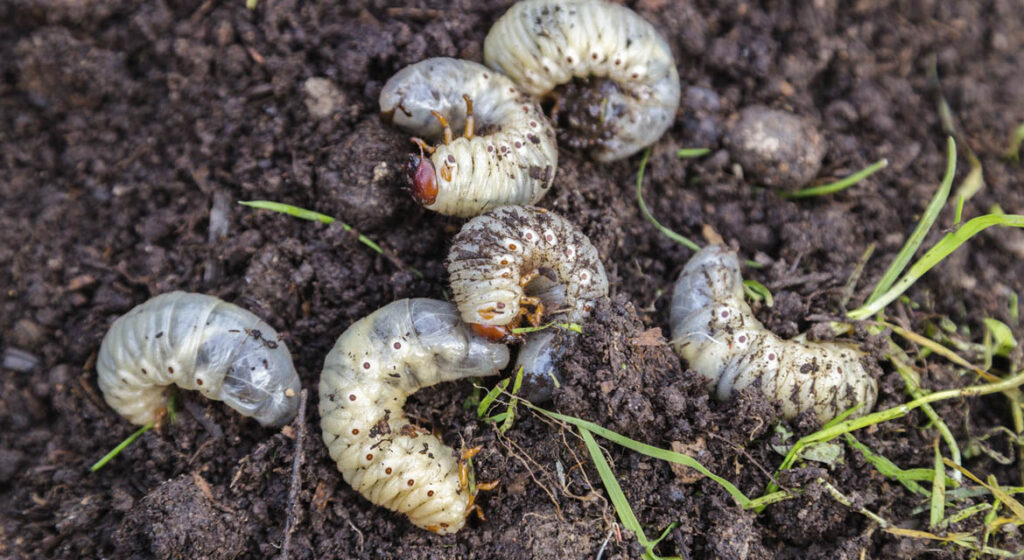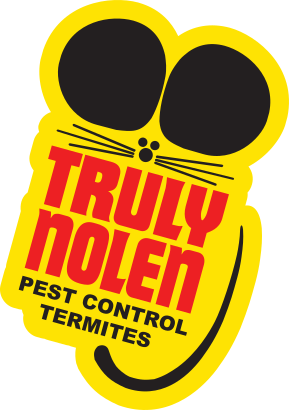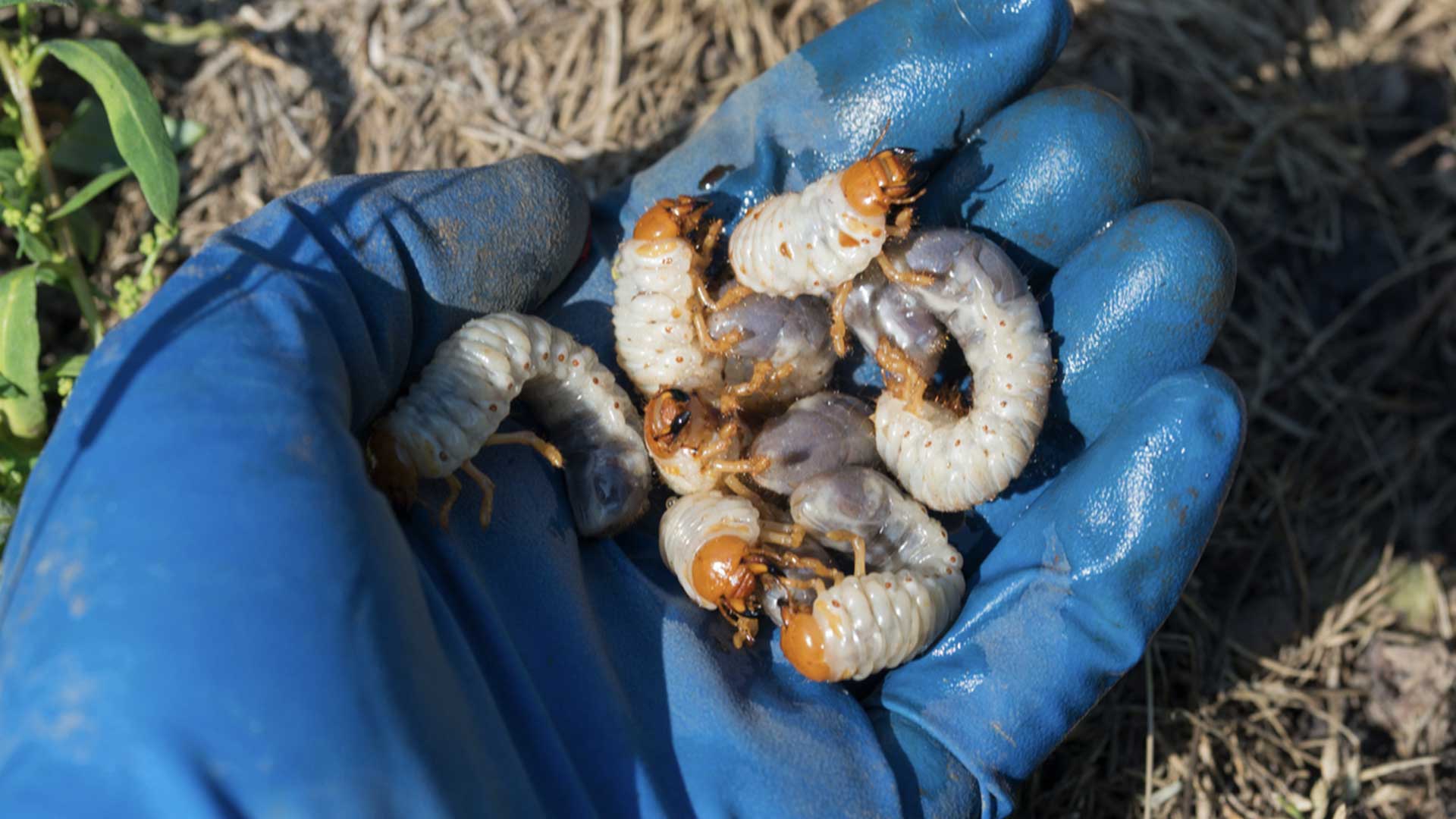
How Do I Know If I Have a Grub Infestation?
Grubs are the small, worm-like larvae of various beetle species that can often go unnoticed until they cause significant damage to your lawn or garden. Here are three key points to watch for:
- Look for signs of damage such as wilting grass, irregular patches or bare spots, and increased activity of birds, skunks, or raccoons, which may indicate a grub infestation in your lawn.
- Inspect the soil and grass roots by lifting a section of turf to find white, C-shaped grubs just below the surface, and check for damaged roots as evidence of feeding.
- Conduct a tug test by gently pulling on the grass in affected areas to assess the extent of damage and count the number of grubs found, indicating the severity of the infestation.
Grub Infestation Overview
Common species of grubs include Japanese beetles, European chafers, and June beetles, among others. These creatures spend most of their lives underground, feeding on the roots of grass and other plants. They are most active during the spring and fall months when soil temperatures are ideal for their development.
Here, we’ll give you ways to identify grubs by their appearance and telltale signs of infestation and offer you options for treating your grub problem. If you suspect a grub infestation, it’s important to take action quickly to prevent further damage. Various curative treatments and preventative products are available, including grub control services, organic matter amendments, and beneficial insects and nematodes to help control grub populations. By taking proactive measures to monitor and control grub activity in your lawn, you can help to maintain a healthy, green turf year-round.
What are Grubs, and What Do They Do?
Grubs are the larvae of different beetle species, including Japanese beetles and European chafers, and can be identified by their white, C-shaped bodies with legs near the head. They typically range in size from 1/4 to 1 inch in length, depending on their species and stage of development. These creatures may start off small and seemingly insignificant, but they can quickly multiply and wreak havoc on your lawn. As they feed and grow, they can damage the roots of grass, making it difficult for the grass to absorb nutrients and water from the soil.
Signs of a Grub Infestation
If you’re a homeowner, maintaining the health of your lawn is likely a top priority. Unfortunately, one common enemy of a beautiful lawn is the grub. How do you know if you have a grub infestation? There are several signs to watch out for:

Truly Nolen GUARANTEE
If you’re not completely satisfied, you’ll get a full refund on your most recent service with our 100% money back guarantee.

$50 Off Year Round Pest Control
Truly Nolen is a family-owned company with 85 years of experience providing the best pest control. If you’re not completely satisfied, you’ll get a full refund on your most recent service with our 100% money back guarantee.
Brown Patches in Your Lawn
If you have a lawn, you know how frustrating it can be to see patches of brown or dead grass. Not only do they detract from the beauty of your yard, but they may also indicate a problem that could spread and damage the health of your entire lawn. A grub infestation is one of the most common causes of brown patches in the lawn. As grubs eat, they create tunnels and air pockets in the soil, which can lead to unstable, spongy areas in your lawn. If left untreated, a grub infestation can cause significant damage to your lawn, leaving you with large areas of bare soil and dead grass.
One of the telltale signs of a grub infestation is these brown patches of grass. The patches may start small but can quickly spread if left untreated. You may also notice that the affected areas of your lawn feel spongy or soft underfoot, which is another indication of a grub infestation. If you pull up some of the affected grass, you may see that the roots are chewed or damaged, or you may see the bodies of the grubs themselves.
Fortunately, there are steps you can take to control a grub infestation and prevent further damage to your lawn. One option is to use a preventative product, such as milky spore or beneficial nematodes, that will kill the grubs before they can do significant damage. Another option is to use a curative treatment, which will kill the active grubs in your lawn. In either case, it’s important to apply the product at the right time of year, typically in late summer or early fall, when grubs are at their most vulnerable.
By addressing a grub infestation early and preventing future infestations, you can keep your lawn healthy and looking its best all year round. Don’t let brown patches in your lawn be a source of frustration – take action today to protect the health and beauty of your outdoor space.
Dead Patches of Grass
Dead patches of grass can be frustrating and unsightly, especially when you’ve put a lot of effort into keeping your lawn healthy and green. But what causes these patches, and how can you fix them?
One common culprit of dead patches is a grub infestation. When they are present in large numbers, they can cause significant damage to your lawn. The result is often dead patches of grass that seem to appear out of nowhere.
Other causes of dead patches can include diseases, drought, over-fertilization, or overuse. For example, a fungal infection such as brown patch can quickly spread through your lawn and cause dead patches. Drought can also cause areas of grass to die off if they aren’t receiving enough water. Over-fertilization can lead to excessive growth, leading to drought stress and making your grass more susceptible to diseases and pests. Lastly, overuse can cause wear and tear on certain parts of your lawn, leading to bare spots.
But if you suspect that grubs are the cause of your dead patches, there are steps you can take to address the infestation. One option is to use a curative treatment, which will kill the active grubs in your lawn. You can also use preventative products such as milky spore or beneficial nematodes to keep grubs from infesting your lawn in the first place.
If the cause of your dead patches is something other than grubs, you can take steps to address the underlying issue. For example, if your lawn is experiencing drought stress, you can water it more frequently or install an irrigation system. If you suspect a disease, you can treat your lawn with a fungicide or consult with a lawn care professional for advice.
A variety of factors can cause dead patches of grass. Identifying the culprit is critical to finding the right solution. With a bit of patience and effort, however, you can restore your lawn to its former health and beauty.
Presence of Adult Beetles
If you’re noticing adult beetles in your lawn or garden, it’s a sign that you may have a grub population lurking beneath the surface. Adult beetles are the mature stage of the beetle life cycle, and they typically emerge from the soil in early summer to feed, mate, and lay eggs. While adult beetles themselves are not harmful to your lawn, their offspring – the white grubs – can cause significant damage to the roots of your grass and other plants.
Several species of beetles can cause problems in your lawn, including Japanese beetles and European chafers. Both of these species have distinctive feeding patterns, with Japanese beetles preferring leaves and flowers and European chafers focusing on the roots of grass. If you’re seeing damage to both the leaves and roots of your plants, you likely have multiple species present.
One way to check for the presence of adult beetles is to place a white sheet beneath any plants you suspect might be affected. Shake the plant gently and see if any beetles fall onto the sheet – if you “catch” any, it’s a good indication that their offspring are causing damage below ground.
So what can you do if you suspect adult beetles are causing problems in your lawn or garden? There are a few different options, depending on the severity of the infestation. If you’re only seeing a few beetles here and there, handpicking them off your plants and dropping them into a container of soapy water can be an effective way to control their numbers.
For more severe infestations, you may need to consider a chemical control product. These can be sprayed directly on the plant or applied to the soil to target the grubs themselves. It’s important to read and follow the label instructions carefully to ensure you’re using the product safely and effectively.
Ultimately, the key to preventing problems with adult beetles and their offspring is maintaining a healthy lawn and garden. Regular watering and fertilization can help keep your plants strong and resilient, making them less vulnerable to beetle damage. And if you do notice any signs of a grub infestation, tackling it early on can help minimize the damage and get your lawn back to its healthy, green state.
Mature Grub Activity
Mature grubs are the larval stage of beetles that can cause significant damage to your lawn and garden if left unchecked. These plump, worm-like creatures can be several centimeters long and feed voraciously on the roots of grass and other plants. As they consume organic matter, they displace soil and cause critical damage to the root system. This results in wilting, yellowing, and eventual death of the plant.
Several distinct signs can indicate the activity of mature grubs in your lawn. One of the most obvious is the presence of brown patches or dead spots. This results from the damaged roots of grass and other plants being unable to absorb water properly.
Another less obvious symptom is the appearance of healthy grass that can be easily lifted from the ground. Mature grubs feed on grass roots, causing them to separate from the soil. When this happens, the turf can be pulled up easily, almost like a carpet.
If the infestation continues, the grass will eventually die off, leaving bare patches of soil. This can happen rapidly, especially during periods of drought or hot weather when the roots of plants are more susceptible to damage caused by grubs.
If you suspect that your lawn is infested with mature grubs, there are a few different control options available. The most effective control method is probably curative treatments that target the mature grubs themselves. Several grub control products are available that can be applied directly to the soil to kill the larvae.
Preventative products can also be applied in the spring or fall to prevent grubs from hatching. These products usually contain milky spore, a type of bacteria that is fatal to white grubs, the most common species of grub that can cause significant damage to your lawn.
In addition to chemical control, there are also a number of organic control options available. Beneficial nematodes, small parasitic worms that prey on grubs, can be introduced into your lawn to target the larvae. Certain species of beneficial insects, like predatory beetles and wasps, can also be introduced as a natural form of control.
The presence and activity of mature grubs can cause significant damage to your lawn and garden if left unchecked. By identifying the symptoms of grub damage and taking appropriate control measures, you can minimize the damage and keep your lawn healthy and beautiful.
Roots Damaged by Feeding
When grubs infest your lawn, they seriously threaten the roots of your grass and other plants. Grubs are the larvae of different beetle species, such as Japanese beetles or European chafers, and feed on the organic matter around the roots of plants.
As grubs feed, they cause significant damage to the roots of plants, which can lead to brown patches, dead spots, and even outright death of the plant. When the roots are damaged, they can no longer absorb nutrients, water, and other essential elements necessary for the plant’s health and growth.
If left untreated, grub infestations can escalate quickly, significantly damaging your lawn and garden. Visible signs of grub damage include thinning turf, dead patches, and sections of grass that feel spongy or have a spongy texture.
Furthermore, the presence of grubs in your lawn can also attract other animals, such as raccoons, skunks, and birds that prey on these larvae. These predators will dig up your lawn to access the grubs, causing more damage.
To ensure that your lawn remains healthy, monitoring and addressing any signs of grub damage as soon as possible is essential. Several methods are available to control grub populations, such as using curative treatments or applying preventative products. The roots of your grass and plants are the foundation for a healthy lawn and garden. Issues like grub infestations must be addressed to protect your investment, and it is essential to understand the signs of grub damage. By being vigilant and proactive, you can ensure that your lawn remains healthy and free from the damaging effects of grub populations.
Assessing the Size and Severity of a Grub Infestation
When dealing with an infestation, the size and severity of the problem are crucial factors to consider. The severity of an infestation can range from minor to severe, and the approach to dealing with it will depend heavily on the extent of the issue.
The Severity of an Infestation
In the case of a minor infestation, it may be possible to address the issue with do-it-yourself methods. For example, if you notice a few white grubs in your lawn, you may be able to treat the affected area with a product like milky spore or beneficial nematodes. Similarly, if you spot a handful of adult Japanese beetles, you might be able to control the population by removing them manually or using a pesticide targeted explicitly at the species.
However, it may be necessary to bring in professionals for more severe infestations. For example, if you notice dead patches or brown spots in your lawn, this could be a sign of a large and active grub population that is causing significant damage to the roots of your grass. In this case, it may be necessary to give us a call. Our trained professionals can assess the extent of the infestation, recommend curative treatments or preventative products, and work to eliminate the active grubs while preventing future generations from taking root.
It’s also worth noting that different species of grubs and beetles can require different approaches when it comes to controlling infestations. For example, European chafer grubs tend to be more resistant to specific treatments than Japanese beetle grubs, and the two species may require different types of products to control their populations effectively.
If left unchecked, a severe infestation can cause extensive damage and lead to the death of grass or plants. As such, it’s crucial to take action quickly when you suspect an infestation is present and to work with experts as needed to address the issue.
Assessing Square Footage Affected by Infestation
When dealing with an infestation of any kind, one of the first steps is to assess the affected square footage. This is an essential step because it helps determine the severity of the infestation and the appropriate measures to take.
For example, in the case of a grub infestation in your lawn, it’s important to determine the size and extent of the affected area. Grubs are known to feed on grass roots, which can lead to brown patches and dead spots in sections of the lawn. To assess the extent of the damage, one should walk around the property and identify the areas that show signs of infestation.
Once you’ve identified the sections of grass that are affected, it’s important to measure the square footage of the affected area. YOu can complete this step by simply measuring the length and width of the affected areas and multiplying them. Grub infestations can spread quickly, so it’s important to regularly monitor the affected areas and determine if the infestation has expanded.
In addition to measuring the square footage of the affected lawn, it’s critical to determine the population of grubs present. Grubs typically have a one-year life cycle, and the larvae stage can last up to ten months. During this time, grubs feed on the roots of grass and can cause significant damage. By determining the population of grubs present, you can select the appropriate measures to control the infestation.
Assessing the square footage affected by an infestation is essential in determining the severity of the issue and the appropriate measures to take. Whether it’s a grub infestation in your lawn or an infestation in your home, measuring the affected area is a vital step in effectively treating and controlling the infestation.
Our Professional Expertise Can Help You Get Rid of Grubs
If you have detected a grub infestation in your lawn, you must take immediate action to control the problem before it becomes more severe. While there are various do-it-yourself methods for managing a grub infestation, hiring a professional pest control service is always wise to get the job done effectively and efficiently.
Our professional services use a range of curative and preventative treatments to eradicate and prevent future infestations. We have trained professionals with the experience, knowledge, and equipment to accurately identify the type of grub and determine the best course of action.
One of the most common methods of controlling a grub infestation is using insecticides. Professionals will apply targeted insecticides to the affected areas of your lawn, ensuring thorough coverage of the soil where grubs are known to reside. Insecticides are designed to kill grubs on contact and are effective against various grubs, including Japanese beetle and European chafer grubs.
Another effective solution for tackling grub infestations is by using beneficial nematodes. These microscopic worms parasitize grubs, killing them off before they can cause significant damage to your lawn. Beneficial nematodes are often used in organic grub control treatments and are harmless to humans, pets, and beneficial insects.
Milky spore is another effective organic treatment option that can help control grub populations. Milky spore is a bacteria that naturally targets Japanese beetle larvae. When milky spore is applied, it infects and ultimately kills off the grub population, thus preventing further infestations.
While there are various DIY methods for treating grub infestations, it’s important to enlist the services of an experienced Truly Nolen professional pest control technician to ensure effective and efficient eradication of the pests. Their expertise and arsenal of treatments can help regulate grub activity and restore your yard to a state of lush greenery and health.

$50 Off Year Round Pest Control
Truly Nolen is a family-owned company with 85 years of experience providing the best pest control. If you’re not completely satisfied, you’ll get a full refund on your most recent service with our 100% money back guarantee.
Frequently Asked Questions
How do grubs damage my lawn?
Grubs damage lawns by feeding on the roots of grass and other plants. This feeding activity weakens the root system, causing the affected areas to turn brown, die off, and become easily detachable from the soil. Learn More!
How do I know if I have a grub infestation?
Signs of a grub infestation include brown or dead patches of grass that can be rolled back like a carpet due to the lack of roots, an increase in wildlife activity like birds or skunks digging up the lawn to feed on grubs, and the presence of adult beetles flying around the affected area. Learn more about grubs
When is the best time to treat a grub infestation?
The best time to treat a grub infestation is typically in late summer or early fall when the grubs are still small and closer to the soil surface. Treating during this period helps prevent further damage to the lawn and reduces the risk of future infestations.
Can I get rid of grubs naturally?
Yes, there are natural methods to control grubs, such as introducing beneficial nematodes or milky spore disease to the soil. These biological control methods target grubs specifically and can help reduce their populations over time.
Do all lawns require treatment for grubs?
Not all lawns require treatment for grubs. If the grub population is low and the lawn shows no signs of damage, treatment may not be necessary. However, if there are visible signs of damage or a history of grub infestations, proactive treatment can help protect the lawn and prevent future issues. Consulting with a lawn care professional can help determine the appropriate course of action.

